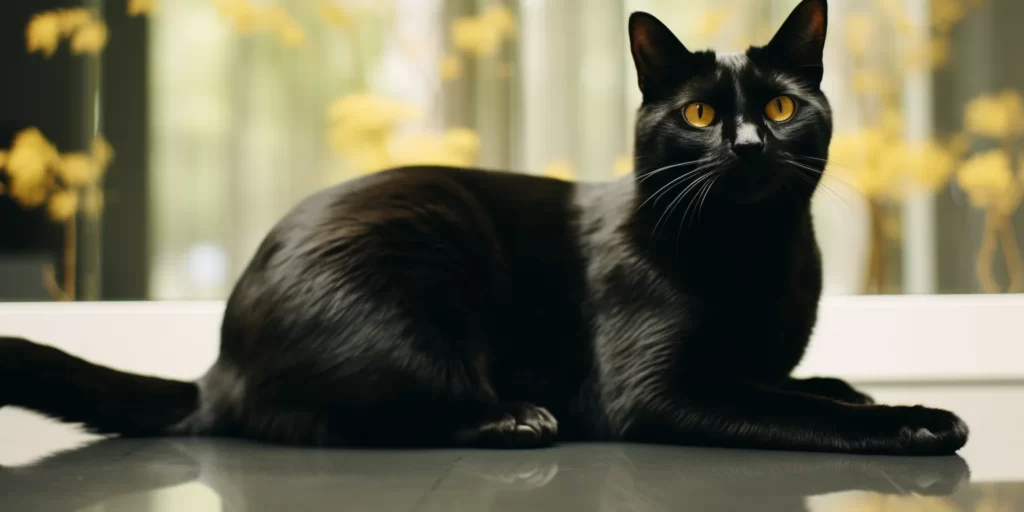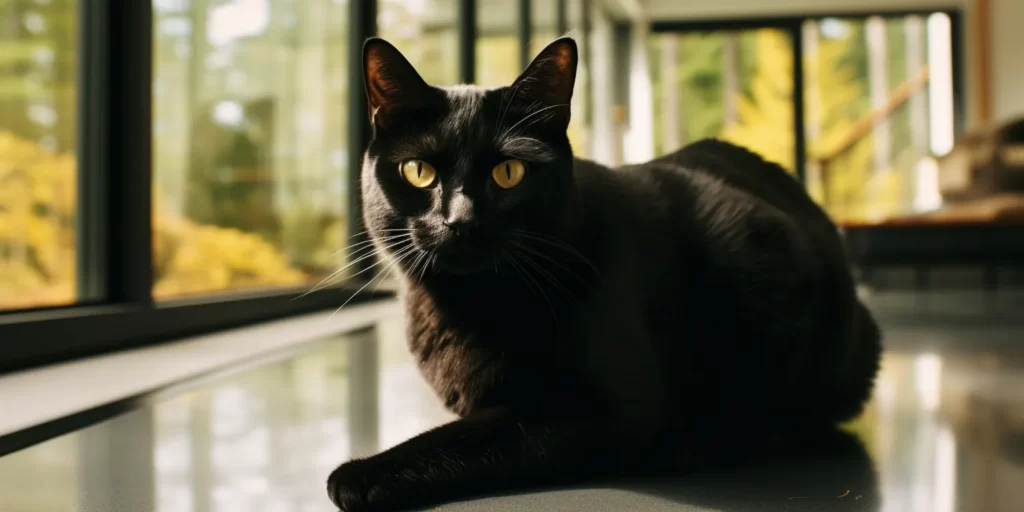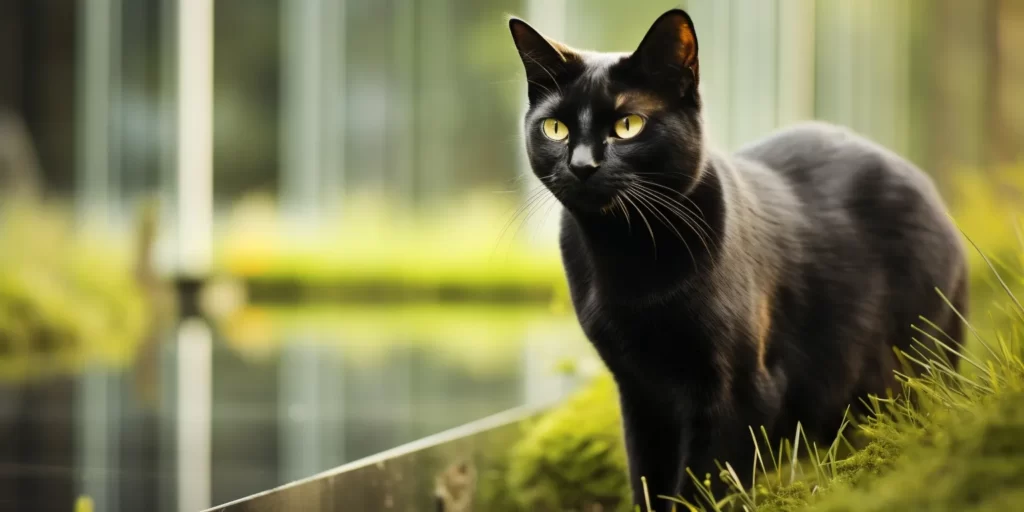When you imagine a little panther prancing around your home, you may very well be envisioning a Bombay cat. This breed, with its sleek, coal-black coat and mesmerizing copper eyes, is the epitome of feline elegance.
If you’re considering bringing a Bombay cat into your life, understanding the costs involved—from the initial purchase price to the lifetime of care—is essential for making an informed decision.
Acquiring a Bombay cat isn’t just about the price tag placed upon these captivating creatures; it’s an investment into a loyal and loving companion. The initial cost represents only a fraction of the total expense involved in caring for your new family member. In this blog, we will guide you through every aspect of Bombay cat prices and what you should expect when budgeting for this breed.
Let’s explore the intricacies of owning a Bombay cat.
- How Much Does a Bombay Cat Kitten Cost?
- Other Factors That Influence the Purchase Price of a Bombay
- Initial Setup and Supplies Cost for Bombay Cats
- The Ongoing Medical Expenses for the Bombay Cat
- The Ongoing Food & Supplies Cost Of a Bombay
- How Much Does It Cost to Insure a Bombay Cat?
- Additional Costs
- How To Save On The Ongoing Cost of Owning A Bombay Cat
- Bombay Cat Adoption Cost vs Buying From a Breeder
- How To Get a Bombay on a Budget!
- Conclusion

How Much Does a Bombay Cat Kitten Cost?
The price of a Bombay kitten typically ranges between $500 and $1000+. This cost variation is influenced by factors such as the breeder’s reputation, geographic location, and the kitten’s lineage and health.
Bombay cats are known for their sleek, jet-black fur and striking copper or green eyes, resembling a miniature panther. These kittens are not only prized for their exotic appearance but also for their friendly and affectionate nature, making them popular among cat enthusiasts.
When purchasing a Bombay kitten within this price range, it’s important to ensure that the breeder provides health guarantees and proof of vaccinations, as well as information about the kitten’s genetic background to ensure a healthy and well-adjusted pet.
The gender of the cat plays a conspicuous role in determining the price. Female kittens are often more sought after for breeding purposes, potentially driving up their cost compared to male counterparts. Additionally, their color is paramount; while Bombay cats are renowned for their lustrous black coats, variations in shade or texture might influence desirability and price.
Moreover, genetics play a crucial role. A kitten from championship stock or purebred lineage will command a higher price due to their superior genetics, tracing back to award-winning ancestors with ideal breed characteristics. This heritage is often reflected in their physical attributes and temperament, making them prize acquisitions for enthusiasts who are willing to pay top dollar.
Other Factors That Influence the Purchase Price of a Bombay

When thinking about getting a Bombay cat, it’s important to consider all the factors that might influence the total cost to avoid unexpected expenses. This includes not only the initial cost of the cat, but also ongoing costs. These recurring expenses include premium food, routine vet visits, vaccinations, and any breed-specific health concerns.
Additionally, Bombay cats require mental stimulation and physical activity, so expenses for toys and possibly even agility or scratching posts can add up. It’s also wise to think about grooming needs, pet insurance, and costs related to spaying or neutering.
By exploring these aspects in advance, you can more accurately budget for a healthy and happy life with your new feline companion.
Age Of The Cat
Bombay Breed will live around 15 years and the age of a cat when you purchase it can significantly affect its cost. Bombay kittens usually have higher demand and pricier fees, but older cats might come at a reduced cost, especially if they’re beyond their prime breeding or show years and looking for a retirement home.
Quality Of The Breed
The cost of a kitten can be significantly impacted by the quality of its breed lines. Bombay cats that adhere more closely to the breed standard, exhibiting the desired physical and behavioral traits with no disqualifying features, are generally more expensive.
Such kittens are often sought after by breeders and enthusiasts who are looking to show their cats in competitions or wish to maintain high breeding standards. Consequently, these kittens command higher prices due to their perceived superiority in terms of lineage and conformity to breed specifications.
On the other hand, Bombay kittens that deviate from these standards, whether through physical attributes or temperament, tend to be priced lower, reflecting their lesser suitability for show or breeding purposes.

Pattern, Color, Body Form
Bombay cats are celebrated for their striking appearance, characterized primarily by their sleek, all-black coats and a robust, muscular build that adds to their panther-like demeanor. This distinct look, reminiscent of a miniature black panther, is a defining trait of the breed.
Consistency in these physical attributes is highly valued in the cat breeding community. Therefore, any deviation from the typical jet-black coat, whether in color or texture, or any variation from the expected muscular physique, can impact the perceived purity of the breed’s characteristics.
Such deviations often result in these cats being less sought after in the market, consequently fetching a lower price than their standard-conforming counterparts. This price adjustment reflects the premium placed on maintaining the breed’s specific aesthetic standards.
Genetics & Health Of The Cat
When purchasing a pet from a breeder, the price you pay can be significantly influenced by genetic health guarantees that the breeder offers. These guarantees, which assert that the animal comes from a lineage free of common genetic disorders, provide prospective pet owners with a sense of security regarding the future health of their pet.
Breeders who invest in genetic testing and selective breeding practices to ensure a healthy lineage typically incur higher costs, which are often passed on to buyers in the form of higher prices.
However, while the initial cost might be greater, the benefit of potentially avoiding expensive veterinary treatments for inherited conditions can make it a worthwhile investment. Thus, when considering the purchase of a pet, it’s important to weigh the peace of mind that comes with a genetic health guarantee against the initial financial outlay.

Availability Of The Cat In Your Area
The scarcity of certain cat breeds, such as Bombay cats, in specific regions can significantly influence their market price. When a breed is rare in an area, the limited availability can lead to higher costs for potential buyers.
For instance, if Bombay cats are not commonly bred or found in your region, acquiring one might entail additional expenses such as shipping fees from locations where the breed is more readily available.
Moreover, if only a few breeders specialize in Bombay cats locally, they might hold a quasi-monopoly, enabling them to set higher prices due to the lack of competition.
The rarity and logistical challenges associated with obtaining such breeds in less populated areas often result in increased financial outlay for enthusiasts looking to own these distinctive pets.
Initial Setup and Supplies Cost for Bombay Cats
Welcoming a Bombay cat into your home requires some initial investments beyond just the purchase price. Here’s what you’ll need to get started:
| Type of Cost | Dollar Amount $ |
|---|---|
| Spay/Neuter: | $200 – $500 |
| Vet Exam and Shots: | $50 – $100 per visit |
| Microchip (recommended): | $40 – $60 |
| Cat Bed: | $20 – $50 |
| Nail Clipper (optional): | $10 – $25 |
| Brush (optional): | $10 – $30 |
| Litter Box: | $10 – $45 |
| Litter Scoop: | $10 – $25 |
| Toys: | $15 – $50 |
| Food and Water Bowls: | $10 – $30 |

The Ongoing Medical Expenses for the Bombay Cat
Healthcare is a vital part of responsible pet ownership, and regular vet visits are non-negotiable when taking care of your Bombay cat. Vaccinations help prevent diseases that can impact your cat’s well-being. While some vaccines are administered once, others require regular boosters.
Vet checkups also offer preventive medical advice and can catch potential health issues early. Don’t forget to account for potential medication costs for any chronic conditions or sudden illnesses. And let’s not overlook Flea/Tick Prevention; keeping your Bombay cat free from pests will ensure their comfort as well as your home’s cleanliness.
The Ongoing Food & Supplies Cost Of a Bombay
Owning a Bombay cat can be a delightful experience, but it comes with its financial responsibilities. The annual cost of caring for a Bombay cat typically ranges between $500 to $1,000, varying with location and individual needs.
A healthy diet and hygienic environment are as vital as medical care for your Bombay’s well-being. Quality food, which might come at a premium price, maintains their sleek coat and overall health. Cat litter is mandatory for indoor cats and needs to be replenished regularly. Teeth cleaning might not seem urgent, but dental health impacts overall well-being and should be attended to.
Over time, expect to replace worn-out items like cat beds and toys—after all, even luxury-loving Bombays love to play! Keep in mind that other supplies may also need periodic replacement due to wear and tear.

How Much Does It Cost to Insure a Bombay Cat?
The cost of insuring a Bombay cat can vary widely depending on several factors, including the cat’s age, health, and the specifics of the insurance plan chosen. Generally, pet insurance policies for cats can range from $10 to $40 per month, with Bombay cats fitting within this range.
However, because Bombay cats are a relatively rare breed, some insurers might charge a slightly higher premium. Factors like the deductible, the level of coverage, and whether the policy includes wellness visits and genetic condition coverage can also affect the monthly cost.
Also, the location where you live can influence insurance costs due to varying veterinary care prices. It’s always a good idea to compare different insurance options and check for breed-specific conditions that might be prone in Bombays, such as heart or respiratory issues, to ensure that the coverage meets your and your pet’s needs.
Accident-only plans typically cover injuries and emergencies but not illnesses, while comprehensive plans cover both accidents and a wide range of health issues.
When selecting an insurance policy, you must also take into account the age and overall health of their cat, as older or cats with pre-existing conditions may face higher premiums.
Additional Costs
Owning an enchanting creature like the Bombay cat comes with hidden fees that only seasoned pet parents may anticipate. Despite their charming demeanor, they may inadvertently damage household items with their sharp claws or shed fur that necessitates more frequent carpet cleaning.
The possible destruction they might leave in their wake isn’t restricted to furniture—their curiosity could extend to shoes or clothes as well! Plus, let’s factor in pet sitting services when you are away or additional cleaning supplies needed to keep up with fur removal from clothing and upholstery.

How To Save On The Ongoing Cost of Owning A Bombay Cat
Being financially savvy with your pet expenses doesn’t diminish the care you provide—it simply maximizes the effectiveness of your budget. Bulk purchases of food and litter can offer savings in the long run.
Comparison shopping for pet needs can uncover less expensive yet quality options. DIY enthusiasts might find joy in crafting homemade toys or treats—this not only saves money but also offers personalization.
Considering pet insurance is another avenue; while it’s an up-front cost, it could spell significant savings on future vet bills. And don’t forget that prevention is always better than cure: keeping up with regular vet visits might mean fewer emergency expenses down the road.
Bombay Cat Adoption Cost vs Buying From a Breeder
Adopting a Bombay cat generally proves to be more cost-effective than purchasing one from a breeder. The cost of adoption can range from $50 to $350, which typically includes spaying or neutering, first vaccinations, and microchipping.
In contrast, buying a Bombay cat from a breeder can be considerably more expensive, with prices ranging from $500 to $1000 or even more. This highly depends on the pedigree, reputation of the breeder, and the genetic lines of the parents.
Furthermore, breeders might not include the additional costs of health checks and initial veterinary care in this price. Adoption not only tends to be lighter on the wallet but also offers a home to a cat that may otherwise struggle to find one, contributing positively to animal welfare.

How To Get a Bombay on a Budget!
If bringing home a Bombay cat feels like a stretch for your wallet, look into adoption from shelters or rescues. Not only could this be less costly than buying from a breeder, but it also gives a deserving feline a loving home.
Platforms like Craigslist, Kijiji, or Facebook Marketplace sometimes offer pets at lower prices—occasionally even free—to good homes due to owners who can no longer keep them. Always approach such transactions with care and consider why the cat may be offered at such low prices. Local community boards can also be an unexpected source for finding cats needing rehoming.
Conclusion
A Bombay cat, with its sleek black coat and captivating copper eyes, offers much more than just striking aesthetics. These cats are known for their affectionate nature, often forming deep, loyal bonds with their families, making them a cherished addition to any home.
However, prospective owners should be mindful of the financial responsibility that accompanies owning a Bombay. Initial expenses such as vaccinations, spaying or neutering, and regular check-ups are just the beginning.
Continuous costs like high-quality food, litter, and occasional grooming should also be considered. Despite these financial considerations, the endless love and companionship a Bombay cat provides can greatly enrich one’s life, offering emotional support that far outweighs the monetary investment.